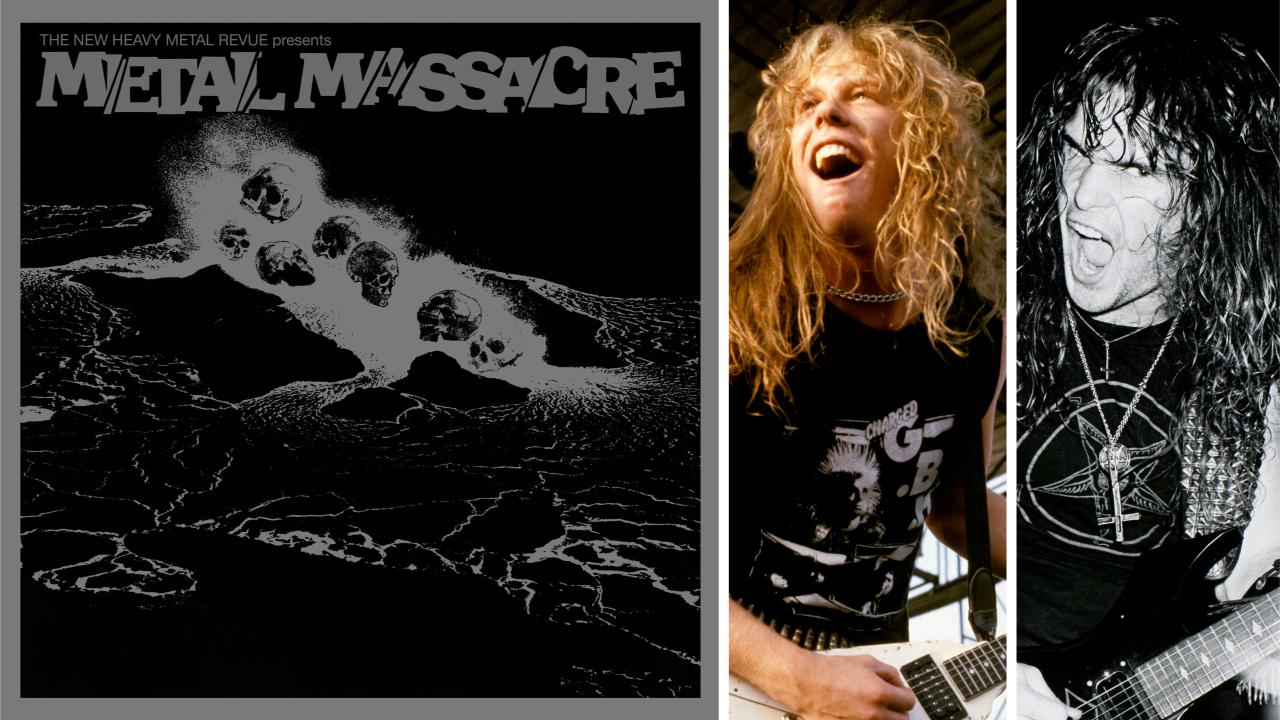
Brian Slagel was just a dude working in a record shop who loved heavy metal. With a passion for his local scene in Los Angeles especially, he drummed up a bit of cash and used some contacts from his job to put out a demo spotlighting nearby unsigned bands. That low-budget tape ballooned into a series, started the prestigious Metal Blade Records and launched the careers of some of ’80s metal’s most titanic bands.
Metal Massacre was just a young man’s passion project in 1982 but, today, is a revered institution among diehard metalheads. The original release contained the first-ever song by some spotty teenagers called Metallica. The second one, out later that same year, featured a newly formed Armored Saint and their future Anthrax frontman of a singer, John Bush. The first original Slayer song to ever be heard was the opening track of Metal Massacre III. Possessed, the first death metal band; East Coast thrash pioneers Overkill; progressive metal forebears Fates Warning – all of them were heard on Slagel’s compilations when they didn’t even have as much as a record label. Without him giving these bands a break, many metal subgenres would be wildly different today.
“Metal Massacre and Brian were a huge, huge part of the beginnings of Metallica,” frontman James Hetfield stated in 2022. “He sparked so many careers by taking chances on young bands.”
Metal Massacre and Brian Slagel were a huge, huge part of the beginnings of Metallica
James Hetfield
The classic Metal Massacres are elusive in 2023. Even though the original enjoyed a 40th-anniversary vinyl reissue last year, you won’t find it – nor any until 2016’s Metal Massacre 14 – on streaming services. Digging on YouTube is the only way to unearth those long-buried demos, but those that do will find some striking artefacts of heavy metal history.
Metallica (erroneously credited as “Mettallica” on the first pressing) closed the original Metal Massacre with a primitive Hit The Lights. Although the song would one year later open Kill ’Em All as a snarling statement of thrash metal intensity, the 1982 version shows 19-year-olds Hetfield and Lars Ulrich aping their New Wave Of British Heavy Metal idols. The singer’s delivery is obviously an imitation of Diamond Head’s Sean Harris, flaunting a melodic wobble that he’d swiftly ditch as the band forged their own identity.
Similarly, on Metal Massacre III, a fresh-faced Slayer supplied Aggressive Perfector and obviously worshipped at the altars of Iron Maiden and Venom. The song would return in more savage form as a bonus track on Haunting The Chapel and Reign In Blood, but here, Tom Araya’s vocals were halfway between Rob Halford and Cronos, his bass as prominent in the mix as Steve Harris’s.

A slot on Metal Massacre was a massive driving force for both bands. According to Slagel, Ulrich (whom he’d befriended in 1980) essentially formed Metallica so that he could appear on the compilation and echo his British metal heroes. “I remember being at his house one day, and he had a drum set in the corner – not put together, just the pieces,” Slagel told Metal Hammer writer Dave Everley in 2022. “He goes, ‘I’m gonna start a band.’ ‘Yeah, sure, Lars, whatever…’ […] Then Lars called me up and said, ‘Hey, if I put together a band, can I be on your compilation album?’ And that, of course, ended up being Metallica.”
Later, in 1983, Slagel discovered Slayer by watching them at a show in Anaheim, California. Araya has stated that repeatedly rehearsing Aggressive Perfector to make it Metal Massacre-worthy is what refined the band’s sheer thrash metal speed.
“We were rehearsing that song over and over and over,” the singer/bassist told Metal Forces in 1991. “The fact is the more and more we rehearsed it, the more we thought, ‘God, this is good, maybe we should do more stuff like this.’ So all the songs that we’d originally written, which were more in the Scorpions and Iron Maiden vein, we dumped and wrote faster stuff and continued from there.”
The two bands’ inclusion in the compilations unintentionally turned the track listings into battlezones. This is especially true of Metallica on the first Metal Massacre, which was otherwise dominated by the likes of Ratt and Bitch: glam bands that the fledgling Four Horsemen loathed. “We’d grown up in L.A. and saw all the B.S., rock-star, big-wig hairdo stuff, and we were so against all of that,” Hetfield told VH1 in 2001.

The war saw Metallica retreat to San Francisco, where they enjoyed kinship with a harder music scene. However, they still had competition – and it came in the form of Slayer.
“I was friends with both bands, and Metallica would ask me, ‘What are Slayer doing? What are they writing?’,” Slagel said to Hammer. “And the Slayer guys would ask me, ‘What are Metallica doing?’ It was, ‘Who’s faster? Who’s heavier?’ They actually played together early on in Orange County. It was really early in Slayer’s career – it was probably only the second or third gig they had played.”
As the two parties carved their own paths, releasing debut albums Kill ’Em All and Show No Mercy in 1983 before becoming cornerstones of thrash’s Big Four, it’s safe to say the competition came to a draw. No one would disagree that Metallica flourished into the mightier commercial force of the two, especially on the monolithic Black Album. However, Slayer are chiselled into history as arguably the fastest, heaviest band to ever exist.
The rapid success of Metallica and Slayer is the jewel in Metal Massacre’s crown when it comes to launching new stars. Even beyond those bands’ individual triumphs though, the compilations should be remembered as the starting point for so many future metal idols. Unintentionally – between Metallica, Slayer, Overkill and the myriad others – Brian Slagel’s demo tapes laid the foundation for the entire decade of heavy music to come.







